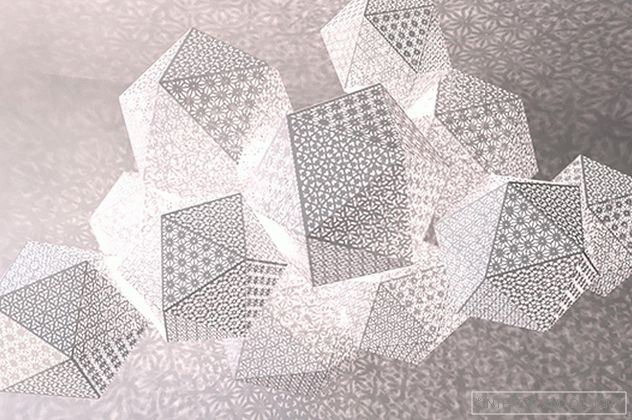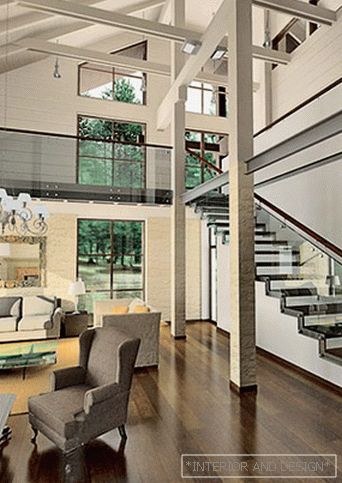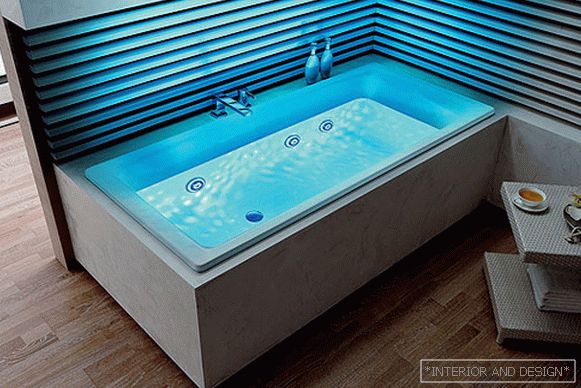Alvar Aalto (Alvar Aalto, February 3, 1889 - 05/11/1976) - the great Finnish architect and designer. The buildings designed by him were included in the architectural textbooks and encyclopedias, the company Artek founded by him is still selling its furniture with success. Over 78 years of his life, Alvar Aalto has built many public and private buildings in Europe, the USA, and even in Iraq. Across Finland, from Helsinki to the small town of Alajärvi, where his parents lived, there are his universities, libraries, museums, theaters, cultural centers, offices, schools and churches. From 1963 to 1968 he was president of the Finnish Academy, in 1957 he was elected an honorary member of the American Academy of Arts and Sciences, became the winner of prestigious architectural awards: the Gold Medal of the Royal Institute of British Architects (RIBA) and the Gold Medal of the American Institute of Architects (AIA).
+ Related: Paulo Mendez da Rocha: RIBA Gold Medal
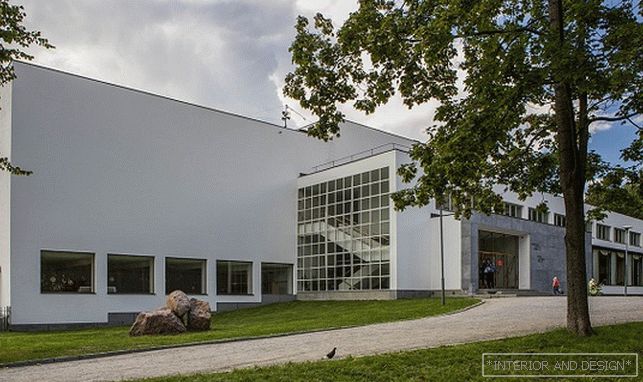 City Library in Vyborg. 1935.
City Library in Vyborg. 1935. We were lucky: one of its most significant buildings is in Vyborg, near St. Petersburg. Three years ago, the library, created by Alvar Aalto in 1935, was solemnly opened after years of restoration, which was conducted by Russian and Finnish experts. Now it is a real pilgrimage site for all those who are not indifferent to the architecture of modernism. In 2015, the project received the highest award of the EU for the preservation of the cultural heritage "Europe Nostra" - the so-called "European Restoration Oscar". This is one of the first projects of Aalto, where his author’s style was fully manifested: a combination of functionalism, which dictates the severity of forms, and soft, smooth organics in interiors, plus ergonomics and focus on the person in everything down to the smallest detail.
Reading room in the Vyborg library after restoration.Aalto has created an excellent natural lighting system for all rooms. The reading room is permeated with diffused light coming through 57 round anti-aircraft lamps in the ceiling. In the center - a spectacular double staircase with a sculpturally curved outline of the railing. In the assembly hall, the famous wavy acoustic ceiling, lined with thin wooden slats, was restored, a detail that became one of the Aalto business cards after the Vyborg library.
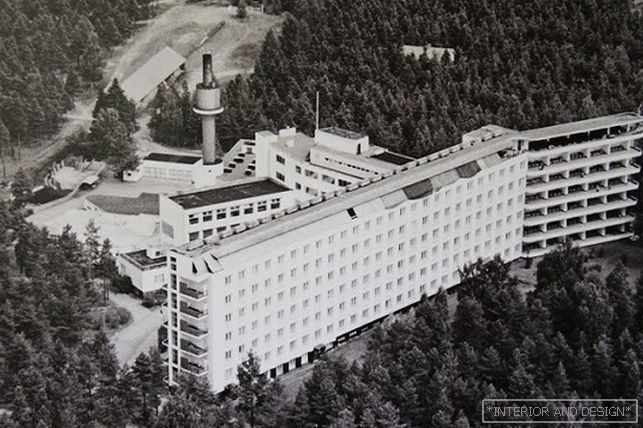 Sanatorium in Paimio, archival photo. 1933.
Sanatorium in Paimio, archival photo. 1933. Aalto was born in a deep Finnish province - probably there he learned to feel and understand nature, the connection with which he so skillfully could later convey in his buildings. He received a degree in architecture in 1921 at the Polytechnic University of Helsinki, but began to build while still a student. His first project is a house for parents in Alajärvi, 1918. In those years he adhered to the neoclassical style. It was difficult to get an order for a novice architect in the capital, so Aalto returned to the provincial city of Jyväskylä, where he studied at the Lyceum, and opened a bureau there. Took orders for private homes. From Jyväskylä, he began a gradual movement towards the capital: first he moved to Turku, and only in 1933 - in Helsinki. In Jyväskylä, about a dozen buildings have been preserved, built by him in the 1920s and later, when he came back here already becoming world famous. This, among other things, the city theater, university and art museum, which now houses the memorial museum of the architect.
“The task of the architect is to revive the correct order of values ... Trying to humanize the age of mechanisms is still his primary duty. But it’s important not to forget the form. ”
Since the late 1920s, Aalto has been actively involved in the global architectural discourse - he travels a lot in Europe, meets architects and artists: Le Corbusier, Poul Henningsen, Walter Gropius, Andre Lurs, Karl Moser, Gerrit Rietveld, etc., - discusses with their principles and ideas, develops their own understanding and gradually becomes one of the leading figures of modern architecture - it was during this period that he built those two buildings that put him in the first row: the library in Vyborg and the tuberculosis sanatorium in Paimio, pine forest near Turku. Contemporaries were amazed by the graceful, honed contours of this complex and no less verified internal architecture.
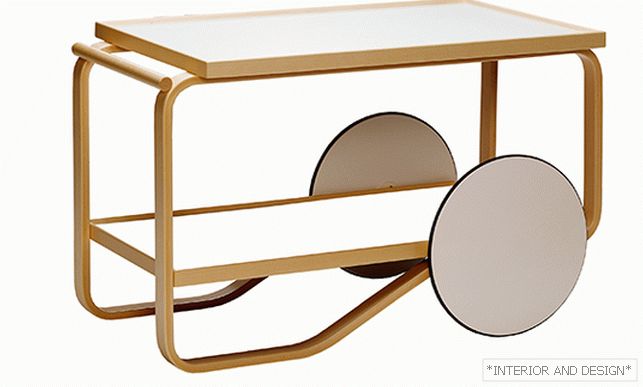 Serving tea table 901, Artek. 1936.
Serving tea table 901, Artek. 1936.  Taburet X601. Artek. 1954.
Taburet X601. Artek. 1954. 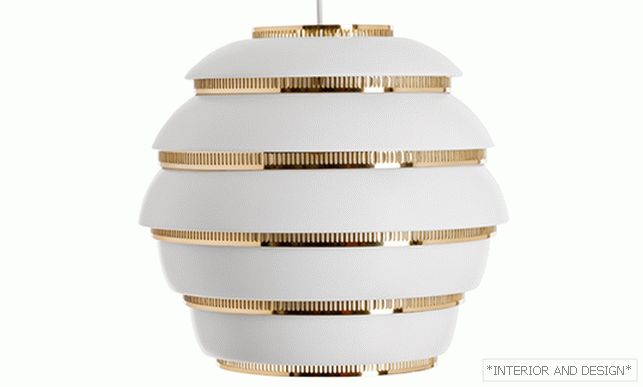 Pendant lamp A331, Artek. 1953.
Pendant lamp A331, Artek. 1953. 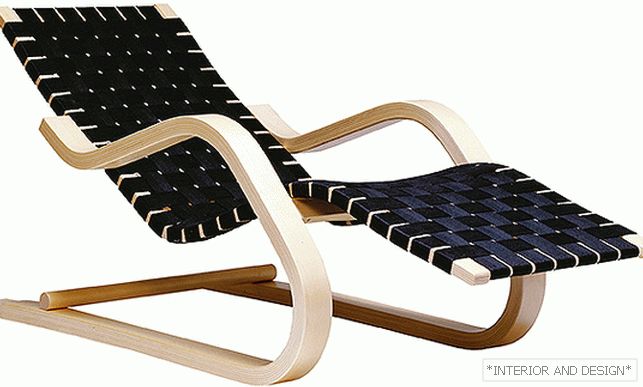 Hezlon 43. Artek. 1936.
Hezlon 43. Artek. 1936. 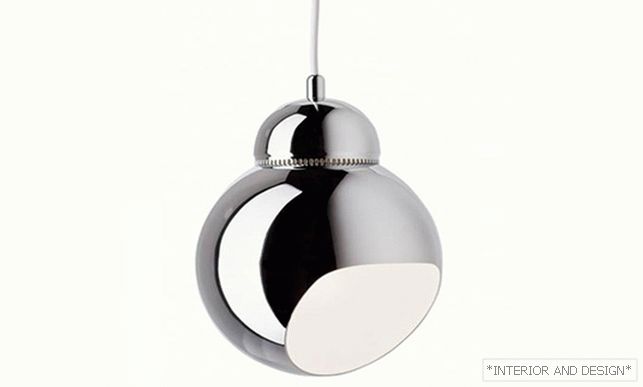 Pendant lamp A338, Artek. 1950.
Pendant lamp A338, Artek. 1950. 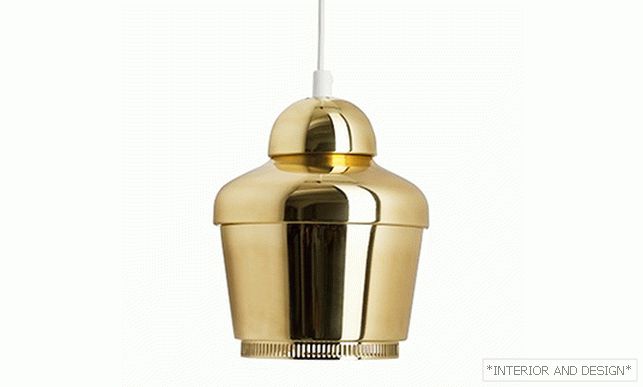 Pendant lamp A330S. Artek. 1939.
Pendant lamp A330S. Artek. 1939. 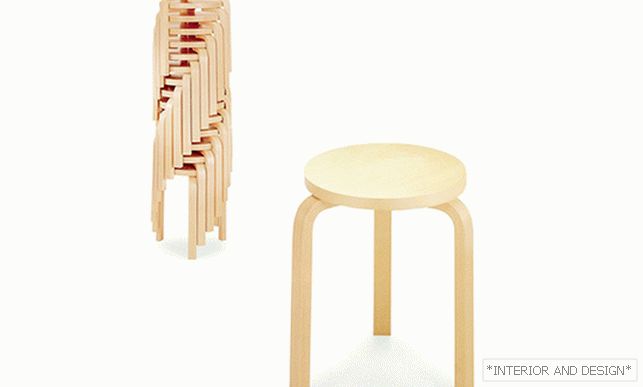 The famous stool 60 stackable stool. Artek. 1933.
The famous stool 60 stackable stool. Artek. 1933. In the sanatorium, everything - from architecture to the smallest details - was supposed to facilitate the recovery of patients. Aalto, along with his wife Aino, who was also an architect, is developing everything for the sanatorium - even shells and containers for receiving tests. Especially successful was the furniture. Paimio's chair was designed so that the person sitting in it maximally opens the lungs. Spring chairs and chaise lounges of bent birch plywood, chairs stacked on each other, leather sofas, functional lamps, mobile trolley tables — all of these items were designed so comfortable and ergonomic that later their industrial production was established.
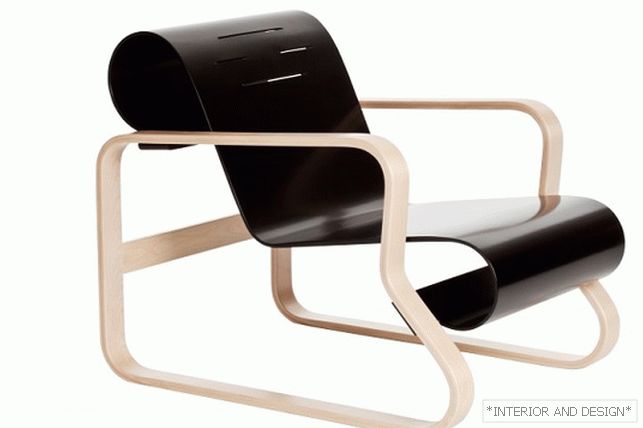 Paimio armchair. 1932. Releases Artek.
Paimio armchair. 1932. Releases Artek. "The leg of the chair is the little sister of the architectural column."
In the early 1930s, Aalto closely cooperates with the Finnish furniture maker Otto Korhonen, they experiment with bent birch plywood and finally patent the technology for the production of furniture from it. The main leg that they patented was the leg L-leg: it was smoothly bent at an angle of 90 degrees. A whole series of chairs, chairs and stools was created on the basis of L-leg, and the first was the legendary stool Stool 60 with a round seat on three supports - Aalto initially used it in the interiors of the Vyborg library. Then began its mass production, which continues to this day. This is one of the most frequently forged furniture models. The original stools produced in Finland, since the 1930s, more than a million have been produced. In total, in the world, different manufacturers produced, according to various sources, up to eight million such stools. Recently, the Stool 60 is a mandatory attribute of all official Apple stores.
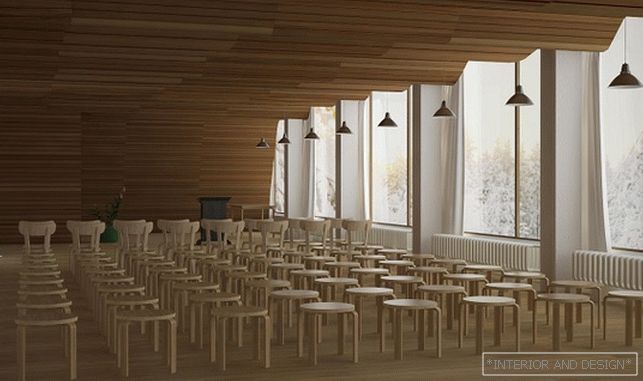 Stool 60 stools in the Vyborg Library conference room after restoration.
Stool 60 stools in the Vyborg Library conference room after restoration. In 1935, Aalto, his wife and a couple of like-minded people founded the company Artek, which meant art + appliances - now the furniture of his design was produced under this brand. Today it is one of the leading Finnish design brands, owning the rights to remakes of furniture created by Aalto and his wife. In addition to furniture, Aalto designed lamps — also for specific architectural objects, and in 1936, on the eve of the world exhibition in Paris, he made a series of glass vases for the Iittala manufactory. The vase, which later became known as the Savoy, won a gold medal in Paris. They said that in it Aalto conveyed the outline of one of the Finnish lakes. The Savoy restaurant in Helsinki, whose interiors were decorated by Aalto, purchased these vases in large quantities, hence the name attached to them. The restaurant, by the way, still works, and Aalto vases stand on each table.
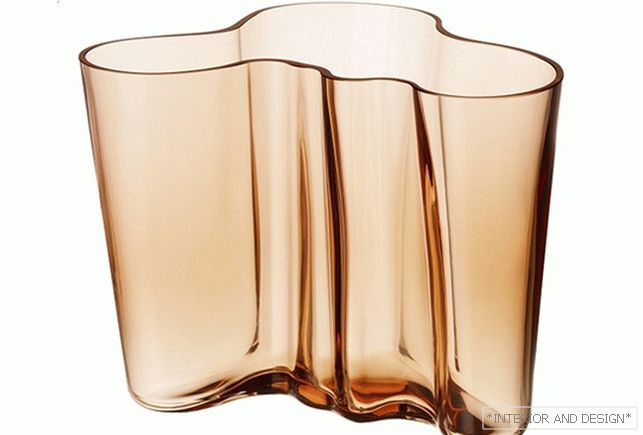 Ваза Savoy, Iittala. 1936.
Ваза Savoy, Iittala. 1936. Aalto’s furniture was the most successful in London - local merchants were involved in sales here, and the bill went to thousands of copies sold, while in Finland itself only dozens. In any case, thanks to the success of his furniture, Aalto had the opportunity to make a short pause in architectural activity, not to chase down orders, but to quietly start building his own house in one of the districts of Helsinki, where he moved.
Villa Mayrea. 1939.The customers of the Villa of Meirea were Aalto's friends — building magnate Harry Gullichsen and his wife Mayre. They gave him a complete carte blanche: no limits either in terms of ideas or in terms of finances. As a result, the outwardly very radical villa was built: nothing to do with the traditional estate and the dominant manor house that the Finns used to use - a building with shifted horizontal "levels", blithely spreading among the pines with the letter L, with an outdoor pool, with a wooden “tower” where the hostess’s art studio is located, with open terraces, a winter garden below and a Japanese garden of stones on the roof.
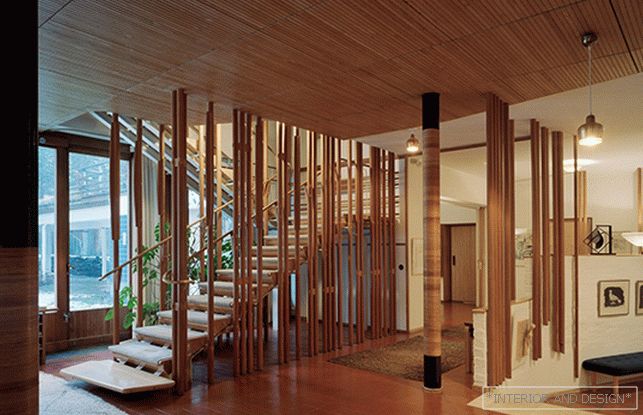 Villa Mayrea. Fragment of the interior of the first floor.
Villa Mayrea. Fragment of the interior of the first floor. On the first floor, all the rooms are combined in an open space and at the same time are separated - in thin Japanese-style columns, with different flooring, and different floor levels. Natural wood, white plaster, terracotta, raw stone slabs, of which fireplaces are made, create a unique combination of modernist and something primordial, archaic, making you feel in a cozy, protected shelter. Villa Mayrea today functions as a museum and is open to visitors, but, unfortunately, there are very few of them, as getting to these remote places is not so easy.
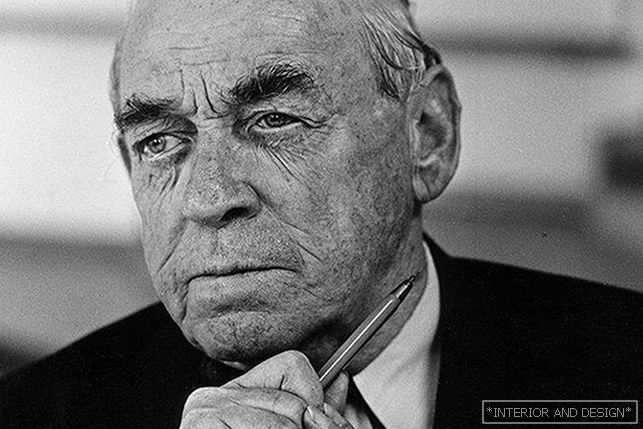 Alvar Aalto (02/03/1898 - 11/05/1976)
Alvar Aalto (02/03/1898 - 11/05/1976) Since 1938, Aalto has been in the United States several times: he is the author of the Finnish pavilion at the World Exhibition in New York, he travels around the country, meets famous American architects, visits the Kaufmann family in their House over the Falls and is almost settled in Massachusetts Polytechnic University, received a place of professor, but because of the Second World War, leaving home. In 1946, he again in the United States, teaches, builds a hostel on the campus of the Massachusetts Polytech - the famous, broad-wave Baker House. Begins a red-brick period in his work. At the same time, he still has not received a single significant contract in Helsinki. And suddenly, in 1948, the Aalto project won the tender for the construction of a pension fund building with the capital. Aalto again in Finland.
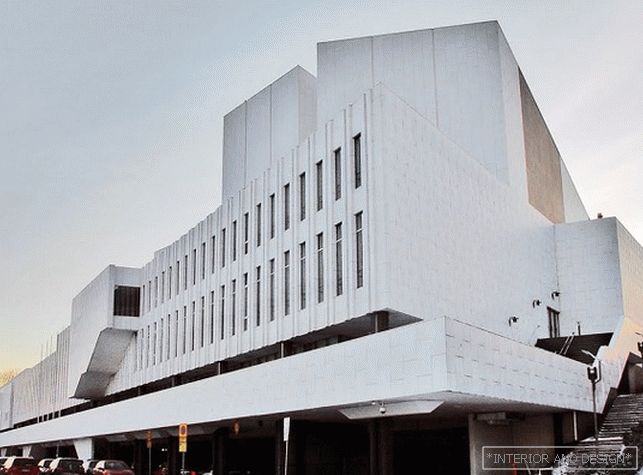 Concert Hall Finland in Helsinki. 1967-1971.
Concert Hall Finland in Helsinki. 1967-1971. In addition to the Pension Fund building, he built several other objects in Helsinki: the monumental and white marble Concert Hall Finland, nicknamed the “iceberg of modernism” (1967-1971), the powerful House of Culture (1952-1958), powerful brick cisterns, Polytechnic University in the satellite city of Helsinki Espoo, with the main audience of the main building (1949–1966), which became Landmark.
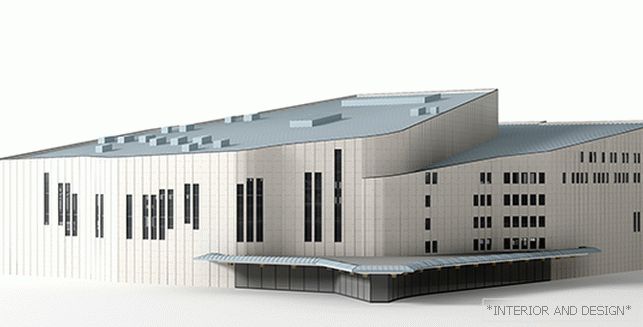 Opera House in Essen, Germany. 1959-1988. 3D model.
Opera House in Essen, Germany. 1959-1988. 3D model. The expressive, child-giving images of the building coexist with other types of buildings in his post-war creativity: these are rectangular functionalist boxes with a large number of regularly spaced windows that look like twins to each other. These appear to be the Building of the Finnish Electric Company (1970), the headquarters of the Stora-Enso concern 1959, and an academic bookstore in the city center (1969). The internal architecture of its buildings is often even more complicated and expressive than the external one: intersecting planes and lines, colliding colors, textures and streams of light resemble the Suprematic compositions pulsating with internal energy.
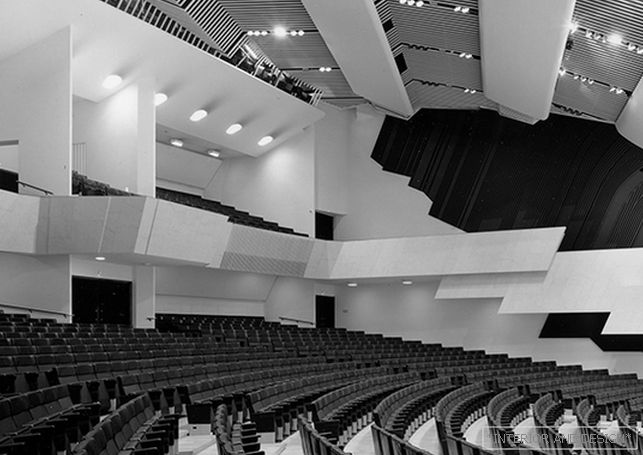 Congress Hall in Helsinki. Finishing: white Carrara marble. Project 1967–71 Finished after the death of the architect.
Congress Hall in Helsinki. Finishing: white Carrara marble. Project 1967–71 Finished after the death of the architect. Aalto treated architectural creativity as a true artist: he did not adhere to any one style, order, concept, each time relying on an image born of imagination, nature was a source of inspiration for him, and his ultimate goal was humanism, service to man.

